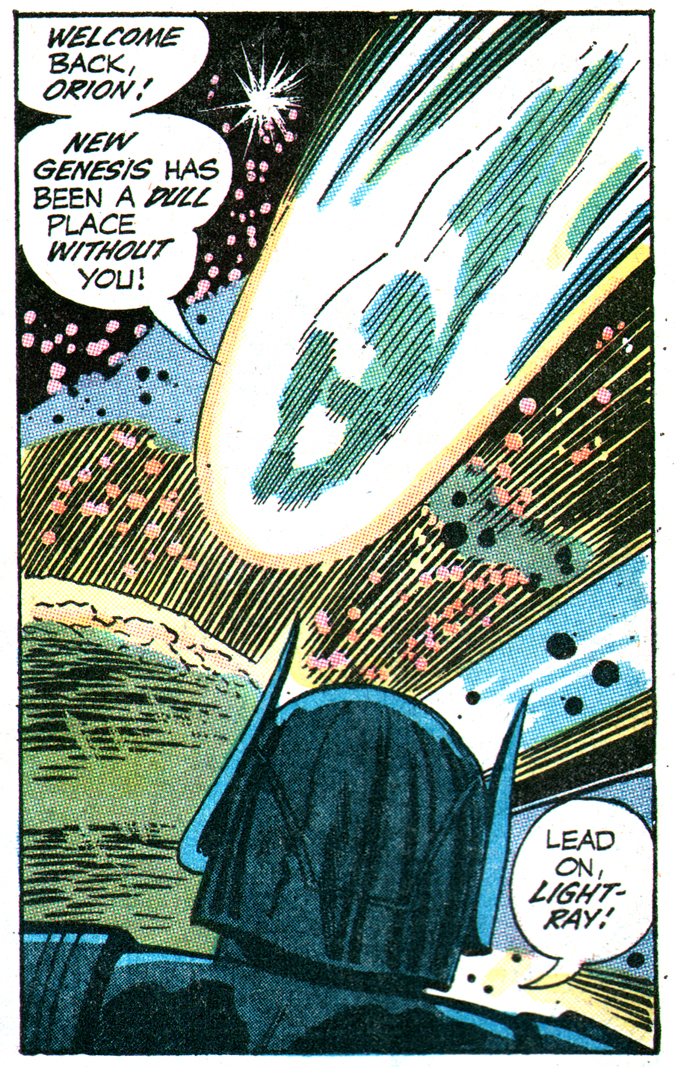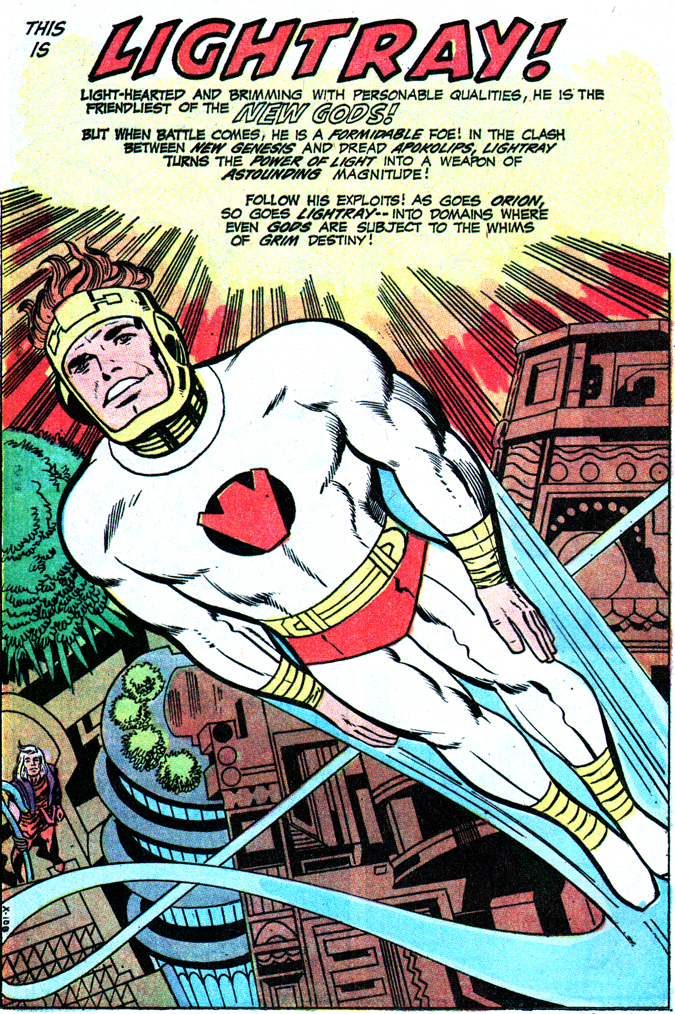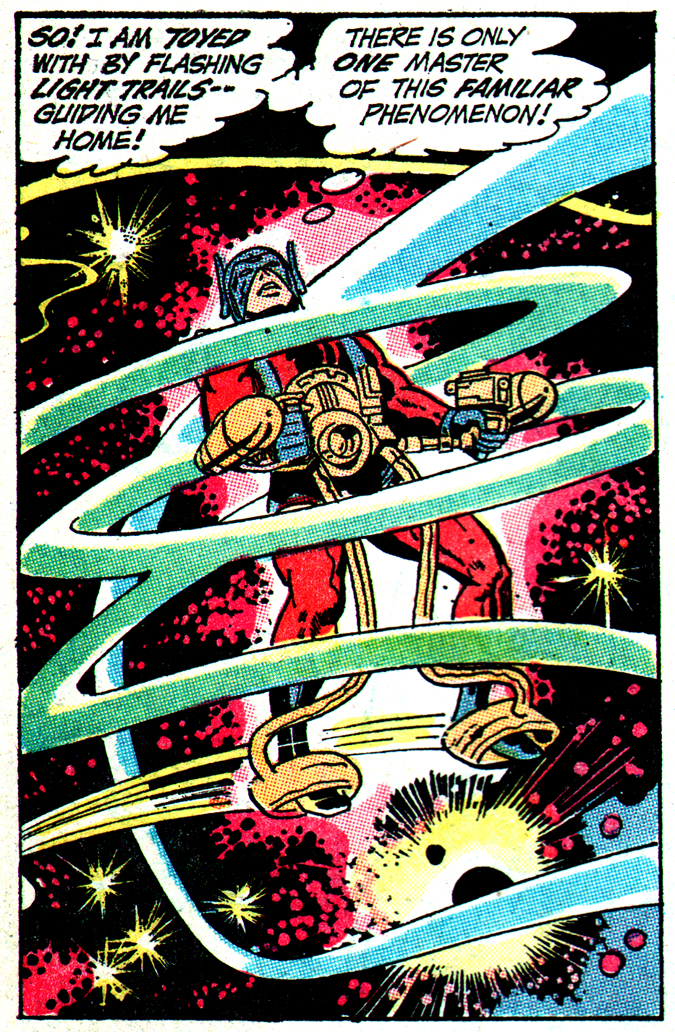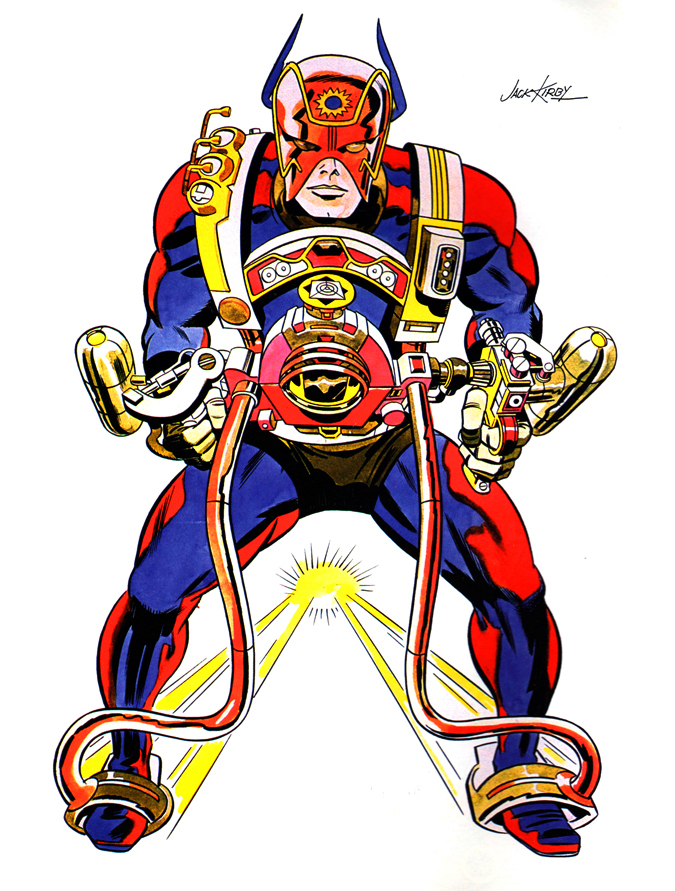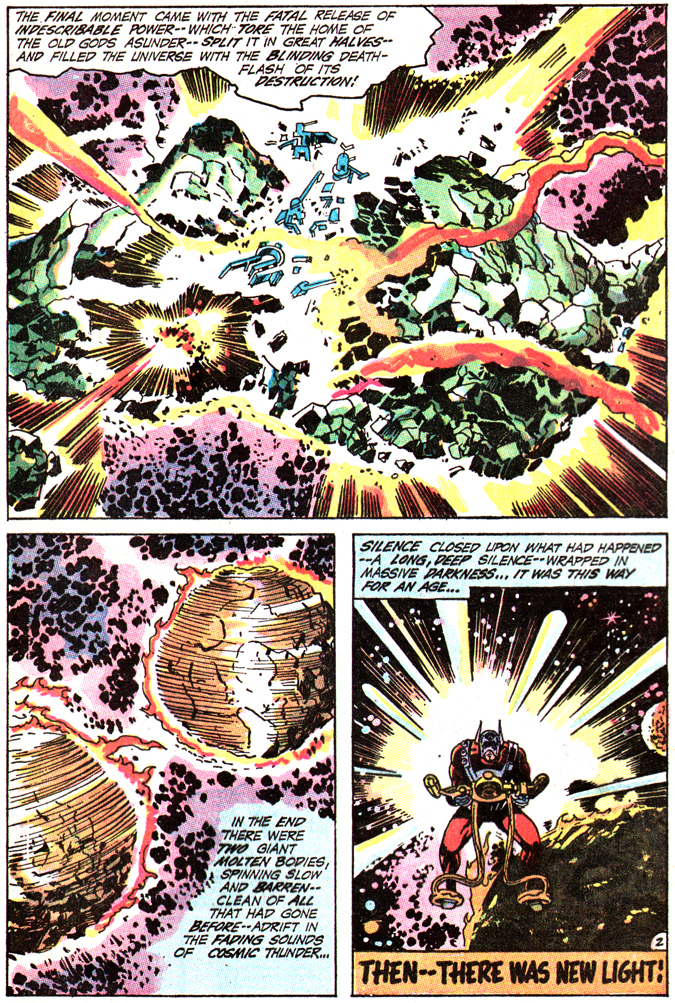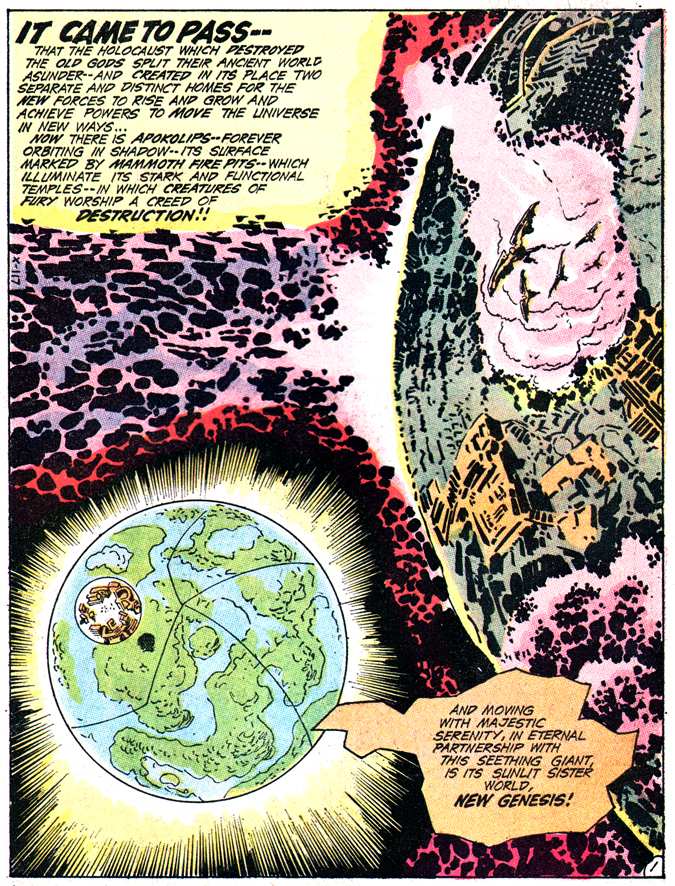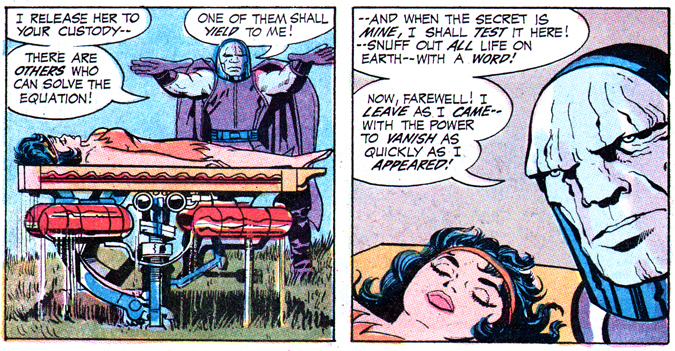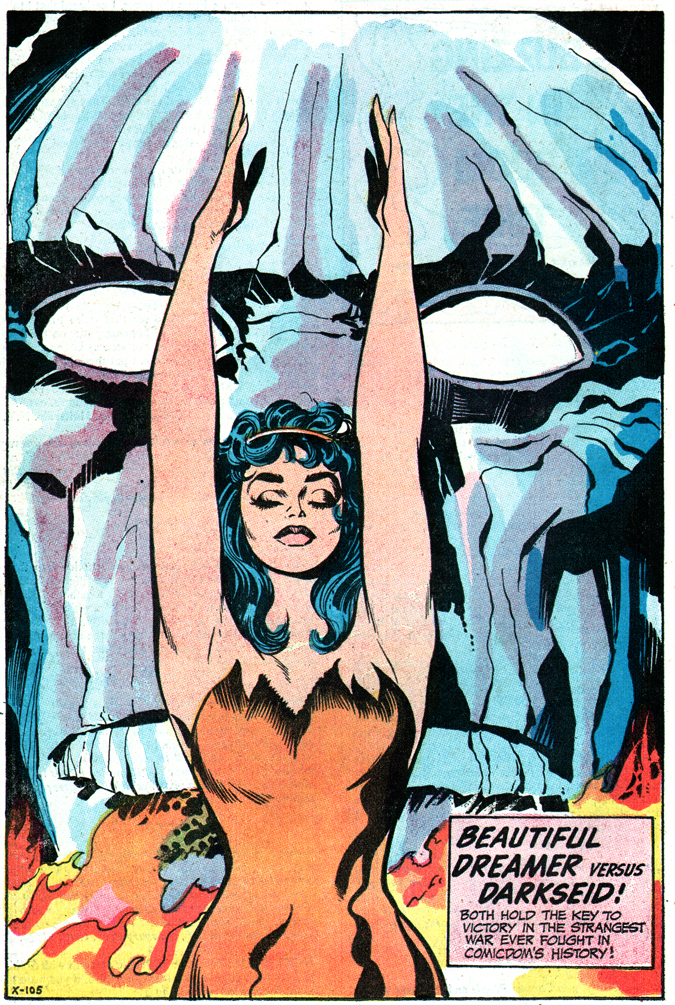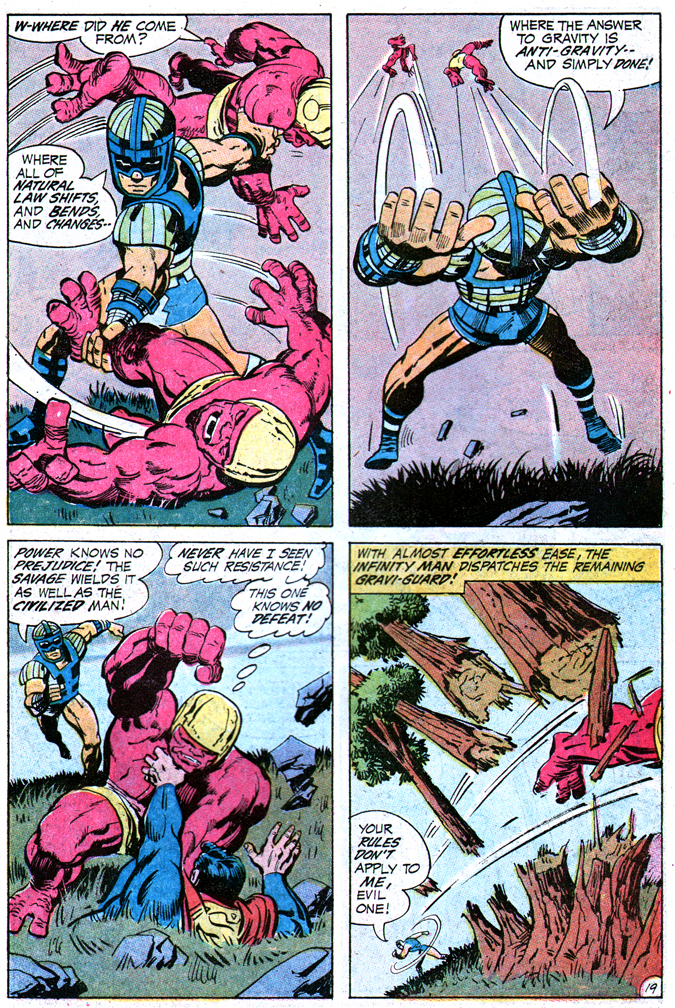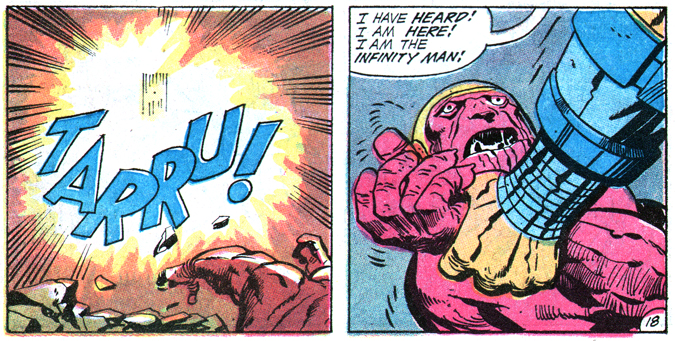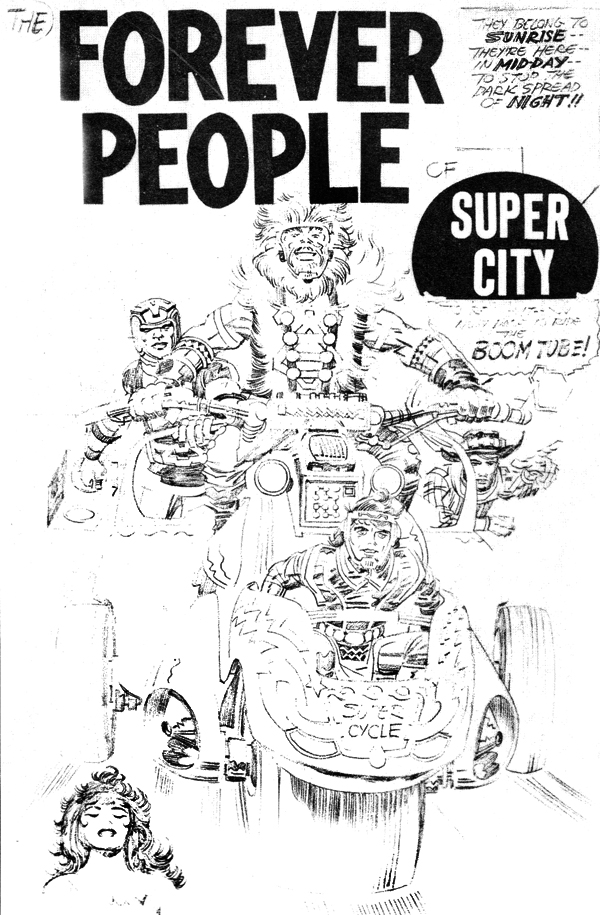Lightray is, according to Jack’s pin-up of the character, “[l]ighthearted and brimming with personable qualities, [and] he is the friendliest of the New Gods! But when battle comes, he is a formidable foe! In the clash between New Genesis and dread Apokolips, Lightray turns the power of light into a weapon of astounding magnitude! Follow his exploits! As goes Orion, so goes Lightray — into domains where even gods are subject to the whims of grim destiny!”
Orion and Lightray are the best of companions, though as contrasting as night and day… or, more aptly said, darkness and light. Orion says, “We are different, you and I… and yet — good friends!” They are compatriots, many times at one another’s side in these opening days of the Super-War.
“I am Lightray of New Genesis, lady!” he tells Eve Donner, “A child of light! — Plunged into war! However, unlike poor Orion — My scars are yet to come!”
Lightray is almost always joyful, telling his friend, “To laugh is to feel the beat of life! Live, Orion! Live!” The young new god is also exceptionally well-mannered, graciously kind to strangers, and a courteous guest, though Lightray is not afraid to berate Orion to mind his manners!
As you can read in the pin-up, Lightray controls the power of light, plus he can fly at (you guessed it!) light speed. “I govern the power of light,” says he. During a fight with Kalibak the Cruel, Lightray emits powerful rays from his hands, called “Solar Thermo-Beams” and “Nova Bursts.”
Even as the New Genesis leader tells our subject, “You are the youngest of those assembled, Lightray! Your time to clash with monsters is not yet here!” Lightray disobeys Highfather and joins Orion’s fight against the Deep Six on our planet, only to be momentarily vanquished, left to die on the Earth ocean, floating on the Deep Six Control Ship, wrapped like a mummy in mutated light-absorbing, steel-fibered kelp.
During that “Glory Boat” adventure, Orion rescues Lightray and lambasts his friend. “Well — well — well –!! So the smiling lamb decided to try his hand among the wolves, after all! Yours is a sorry welcome to Earth, Lightray!! I see your first brush with war — and The Deep Six — has been little short of disastrous!!” The fierce son of Darkseid comments moments later, “It saddens me to see you here, Lightray! Your kind brings an undeserved honor to war!!”
It is during this sea battle when we see a more complex side to Lightray, one that might be allegorical when it comes to civilians waging war instead of generals. On the Deep Six’s Control Ship, in lieu of joining Orion in decimating the mutated “organic director” — a “Sender” — he tells his friend, “It shouldn’t be destroyed!! It should be changed!!” And the young god uses his powers to transform the misshapen creature: “Light! Light! — Not to glisten on swordblades! — But light at play with atoms — to make them sing in other ways!!”
It is reduced to a “white-hot compact core,” a brilliantly glowing cube. “It’s now a living basic life form!! — Stripped of the taint of Apokolips,” says Lightray. Adds Orion, “It will grow again — in the image of New Genesis!” Using his Mother Box housed on the forehead of his facial harness makes the new critter a “Caller,” which will eventually bring the enemy to them.
When next we see the “Caller,” it has morphed from a “Life Cube” into an organic, evolving machine… It has become “Techno-Active.” Then, in perhaps the most climactic — and dramatic — moment in all of Jack Kirby’s enormous body of work, the “Caller” is now the ultimate weapon of New Genesis, “singing and shining and sleek and deadly!!! What Lightray has ‘imprinted‘ on the ‘Life Cube‘ is now fully ‘grown!‘ And it carries on its glistening warhead the living — the dead — and the fiery trumpets of the Source!!!” Like Berzerkers rushing wildly into battle without care for life or limb, the “Glory Boat” careens head-on towards the Deep-Six and their monster Leviathan! “The trumpets blast on impact with the enemy! Thunderous notes! — White-hot, elemental and all-consuming!! A Wagnerian offering to the Source!!”
But the complexity of Lightray’s machinations is found in Orion’s distress before the final showdown. “You fight battles like a planner,” Orion screams, “instead of a warrior!! The enemy — myself — this dead boy — and his father — We’re all your pawns!!” It’s a curious moment and worth pondering. The look and effect of this, the “Glory Boat,” sure appears thermonuclear, and why can’t I shake the vision of Robert McNamara and his fellow “Best and the Brightest” out of my head? The most noble of intentions…
Nearing the end of the saga as published, after Orion has survived another titanic battle, Lightray beckons the dawning sun to bathe his wounded comrade: “Then, let the coming light be bright and strong — let it play upon those wounds — let it bring things that wash — the pain — with — pleasantries — Then let me aid the light! Let me give my added power where it can hasten all the good things this day may hold for brave Orion!”
There’s a notable moment in The New Gods #3, when The Black Racer is chasing down Lightray. The harbinger of death exclaims: “Destiny has decreed that our paths should cross!” And yet, with the assist of Metron, Lightray dodges that fatal bullet. But it led me to wonder if Lightray, bright, cheerful, full of hope and happiness Lightray, was predestined for an “untimely” demise…
Because, y’see, though I know he appears later in “Wild, Wild Wedding Guests” (Mister Miracle #18), in the final issue of The New Gods, Lightray seizes the initiative of the “Combat Code” to take on Kalibak and embrace, in his words, “the rare shock of battle,” and the half-brother of Orion slams the young god (apparently) to a bloody pulp. But with the Black Racer coming for either Orion or Kalibak, Jack forgets to tell us the fate of Lightray (or did I miss something?). Was Lightray to have been beaten to death by Kalibak the Cruel?
Is Lightray doomed from the start? Is dear, sweet, beautiful Lightray one of the gods “subject to the whims of grim destiny”?


